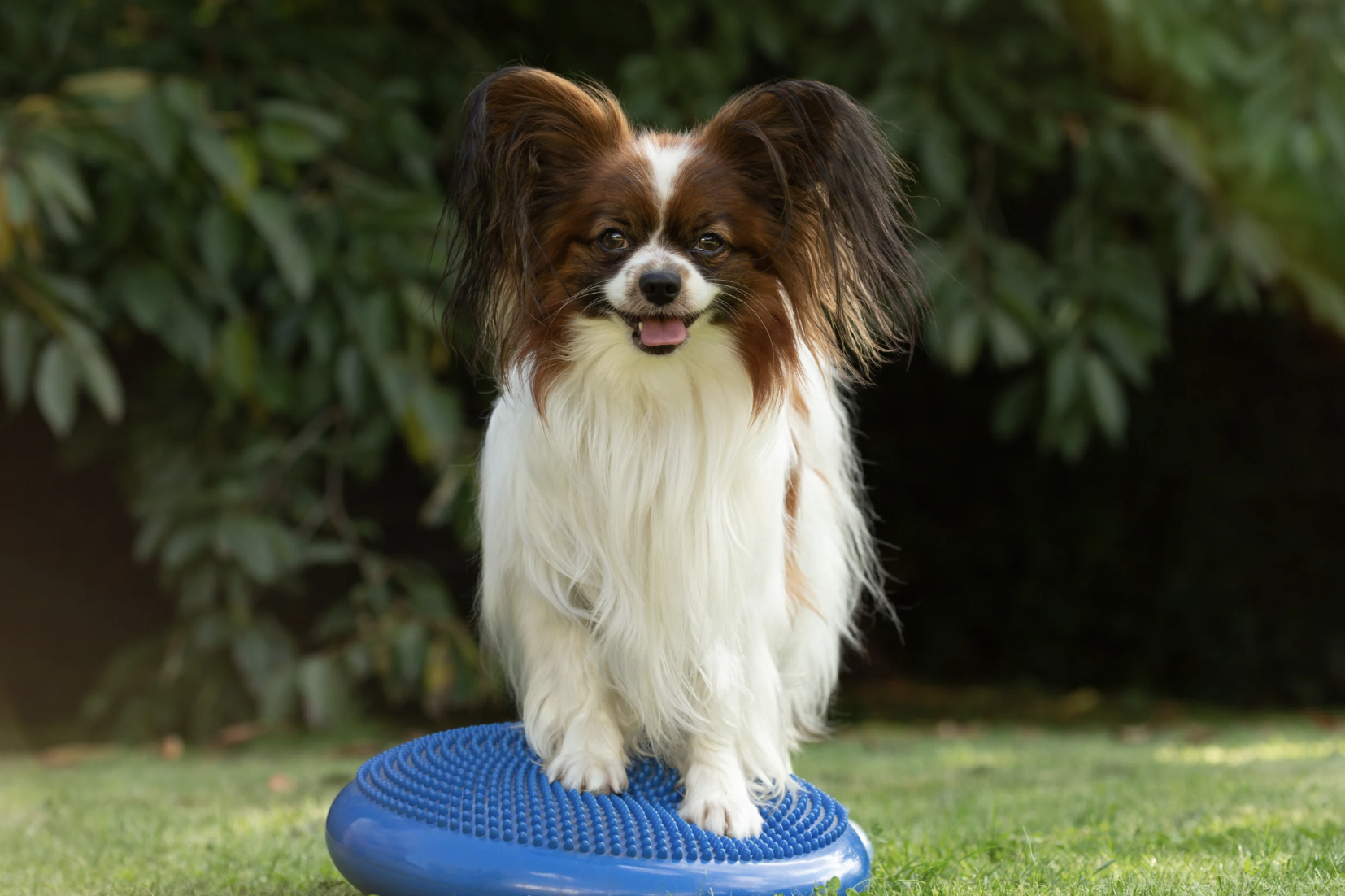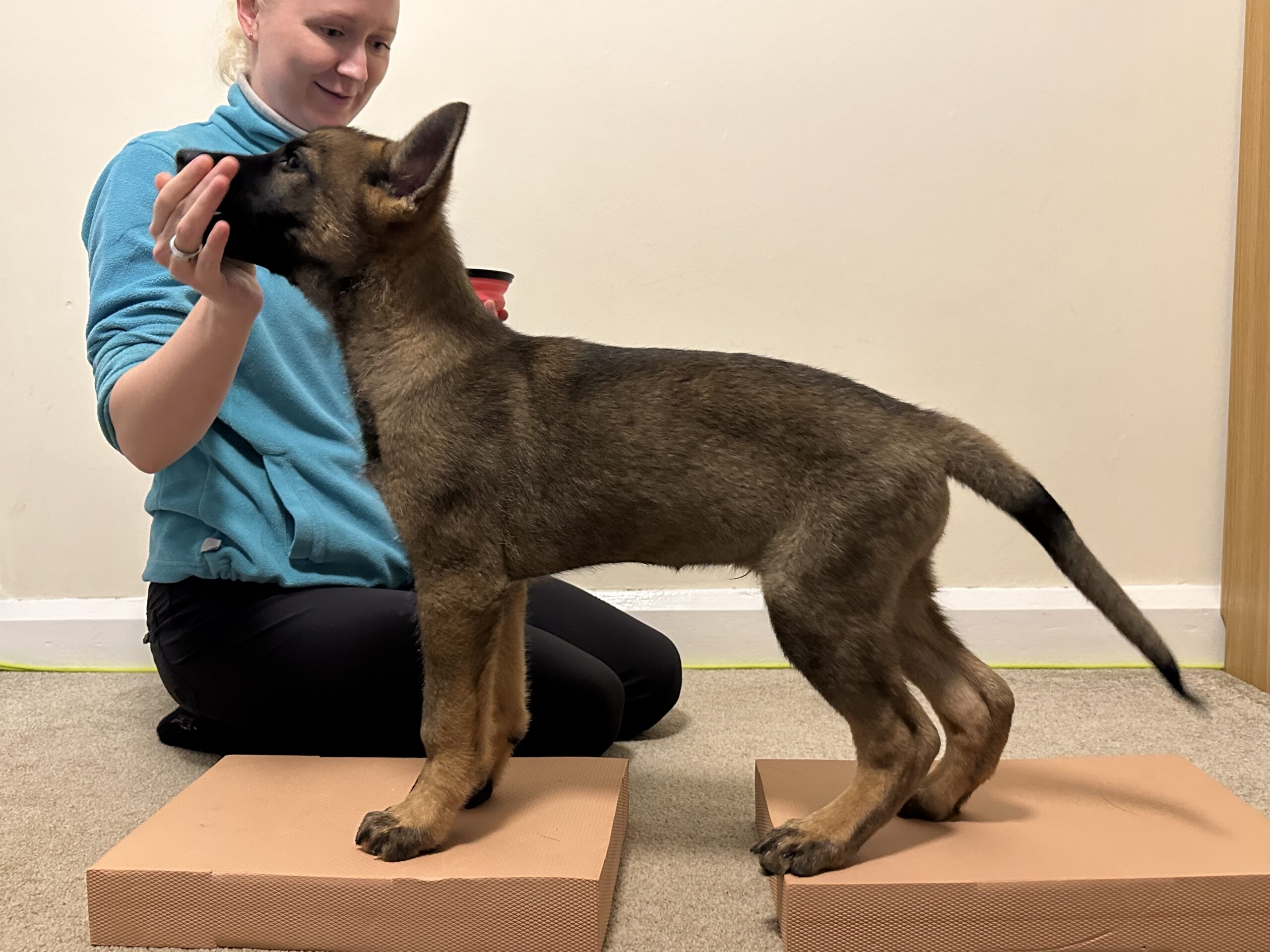More dog owners are beginning to recognise the benefits of integrating veterinary physiotherapy with traditional dog training to keep their dogs healthy and happy.
Incorporating physiotherapy into a training plan allows exercises to be tailored to enhance a dog’s overall well-being. This approach not only improves physical health but also supports behavioural balance.

Key benefits for both puppies and older dogs:
- Reducing the risk of injury through targeted conditioning
- Identifying weaknesses that may impact mobility
- Enhancing stability, strength, and coordination
- Improving proprioception for better movement control
- Supporting injury prevention and long-term health
- Detecting hidden pain before it affects behaviour
- Increasing a dog’s comfort with handling and training by different people
By combining structured training with physiotherapy, we can create a well-rounded program that optimises a dog’s physical and mental welfare.
In this post, we’ll explore the fundamentals of veterinary physiotherapy, the common conditions it addresses, and how it can benefit dogs of all ages, from rambunctious puppies to wise seniors.
What Is Veterinary Physiotherapy?
Veterinary physiotherapy is a specialised field dedicated to improving the physical health, mobility, and overall well-being of animals through targeted therapeutic techniques. These may include:
- Manual therapy (such as massage and joint mobilisations)
- Electrotherapy (like laser therapy and ultrasound)
- Tailored exercise programs to enhance strength and movement
Much like human physiotherapy, the goal is to rehabilitate pets, manage pain, and promote recovery from injuries or surgery. However, an often-overlooked benefit is injury prevention, which is crucial for working, sporting, and competition dogs.
Common Conditions Treated by Veterinary Physiotherapists
Veterinary physiotherapy is beneficial for a wide range of conditions, including:
- Arthritis – A common issue in older dogs, leading to joint pain and stiffness
- Post-surgical rehabilitation – Helping dogs regain mobility and strength after surgery
- Muscle injuries – Addressing sprains, strains, and tears caused by exercise or play
- Neurological conditions – Supporting dogs with coordination and mobility challenges
- Weight management – Encouraging safe and effective exercise for overweight dogs
How Can Veterinary Physiotherapy Benefit My Dog?
Integrating veterinary physiotherapy with dog training provides numerous benefits for dogs of all ages:
- For older dogs – Improves mobility, reduces discomfort, and enhances quality of life
- For puppies – Helps establish proper movement patterns and addresses early developmental concerns
- For active dogs – Reduces the risk of injuries and enhances performance
- For anxious or reactive dogs – Rehabilitation techniques can promote relaxation, focus, and confidence

Even if your dog is young and appears healthy, physiotherapy can serve as preventative care, reducing the likelihood of future injuries and ensuring long-term well-being.
What to Expect from a Veterinary Physiotherapist Consultation
During a veterinary physiotherapy consultation, expect a thorough assessment where the physiotherapist will:
- Review your dog’s medical history and any previous injuries
- Conduct a gait analysis to assess movement and posture
- Identify areas of pain, stiffness, or dysfunction
- Develop a personalised treatment plan, which may include targeted exercises, massage, or other therapies
Each session is designed to be both effective and engaging, often incorporating play-based techniques to keep your dog motivated.
Veterinary Physiotherapy vs. Massage: What’s the Difference?
While massage is a valuable component of physiotherapy, veterinary physiotherapy is a broader discipline. It combines multiple techniques—including targeted exercises, joint mobilisation, and electrotherapy—to support recovery, prevent injury, and improve physical function, whereas massage focuses primarily on soft tissue relaxation.
Veterinary Surgeon vs. Veterinary Physiotherapist: Who Does What?
A veterinary surgeon diagnoses conditions, performs surgeries, and prescribes medications.
A veterinary physiotherapist focuses on rehabilitation, mobility, and pain management through non-invasivetechniques.
Both professionals play essential roles in a dog’s healthcare, often working together to provide a comprehensive treatment plan.
Veterinary Physiotherapy vs. Hydrotherapy
Veterinary physiotherapists use a wide range of treatments, including manual therapy, electrotherapy, and exercise-based rehabilitation.
Hydrotherapists specialise in water-based therapy, such as swimming and underwater treadmill exercises to support recovery and conditioning.
While hydrotherapy is often incorporated into physiotherapy programs, physiotherapists offer a more extensive range of treatments tailored to individual needs.
Useful UK Websites for Dog Training and Veterinary Physiotherapy
For more information on veterinary physiotherapy and how it complements dog training, check out these resources:
Veterinary Physiotherapy & Rehabilitation Associations:
- National Association of Veterinary Physiotherapists (NAVP)
- Association of Chartered Physiotherapists in Animal Therapy (ACPAT)
- British Veterinary Physiotherapy Association (BVPA)
- Institute of Registered Veterinary & Animal Physiotherapists (IRVAP)
- British Veterinary Rehabilitation and Sports Medicine Association (BVRSMA)
Canine Rehabilitation & Training Resources:
- Canine Hydrotherapy Association (CHA)
- Canine Arthritis Management
- The Kennel Club
- The Institute of Modern Dog Trainers (IMDT)
Combining veterinary physiotherapy with structured dog training helps create stronger, healthier, and more resilient dogs. Whether you’re supporting a senior pet, conditioning a competition dog, or preventing injuries in an active pup, this holistic approach can make a world of difference.
Disclaimer: The information provided in this blog is for informational purposes only. Read our full Disclaimer.








Comments are closed